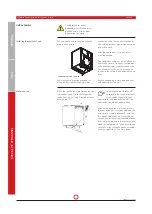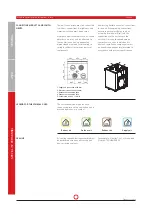
OPERATING AND INSTALLATION INSTRUCTIONS LG 250 A
PAGE 32
Changes reserved
U
S
ER
G
ENER
A
L
S
P
EC
IA
LIS
T
P
ER
S
O
NNEL
The basic design of a domestic ventilation system is
illustrated in the pictorial schematic with optional
additional system enhancements.
1 Unit housing
2 Supply air fan with EC technology
3 Exhaust air fan with EC technology
4 Filter ODA ISO ePM2,5 65% (outdoor air)
(optional filter ODA ISO ePM1 80%)
5 Filter ETA ISO Coarse 90% (extract air)
(optional filter ETA ISO ePM10 75%)
6 Counterflow heat exchanger
7 Bypass flap for Summer mode
8 Frost preheating heat exchanger (optional)
9 Condensate tray with onsite drainage and
effective odour trap (siphon)
10 Pipe connection
11 Silencer (optional)
12 Switching flap (optional)
13 Reheater battery - electrical or with water
(optional)
14 Geothermal exchanger EWT (optional)
15 Suction element with pre-filter for EWT
16 Sole-geothermal exchanger (optional)
There is a risk of the heat
exchanger freezing on the
exhaust air side, particularly
during winter months with moderate to
severe frost, depending on the extract air
temperature and air humidity. Appropriate
measures must be taken to protect the
heat exchanger against ice formation at
low outdoor air temperatures of under
approx. -4 °C.
Various systems are available to monitor
defrosting of the heat exchanger. Possible
strategies to protect against freezing are
outlined below.
SYSTEM ENHANCEMENT OPTIONS FOR
FROST PROTECTION
Optimal frost protection can be achieved
with cold outdoor air temperatures by
integrating a geothermal heat exchanger
into the ventilation system. Additional
components, such as a PTC pre-heater
battery integrated in the ventilation unit,
are not necessary.
In summer mode, the
geothermal heat exchanger's
cooling performance is
determined by the low rate of air
exchange, is very limited and is barely
perceptible to the user.
The following information must be
observed for execution of a geothermal
heat exchanger:
• The heat exchanger is laid in the ground
with waterproof pipes at a frost-free
depth with due consideration of the
system's cleanability options.
• The manufacturer's guidelines for
implementation must be observed.
• Condensate drainage must be provided.
• If the air pipe is routed through an
external wall, effective sealing against
moisture ingress must be ensured.
• Sufficient distance from other parts, e.g.
water pipes, foundations, etc. must be
maintained during positioning in order to
prevent frost damage.
• Indirect pre-heating possibilities via a
circulatory system with frost-protected
heat carrier, for instance, should
preferably be used in ground containing
hazardous substances (e.g. radon
contamination).
Geothermal exchanger EWT
(factory setting)
















































